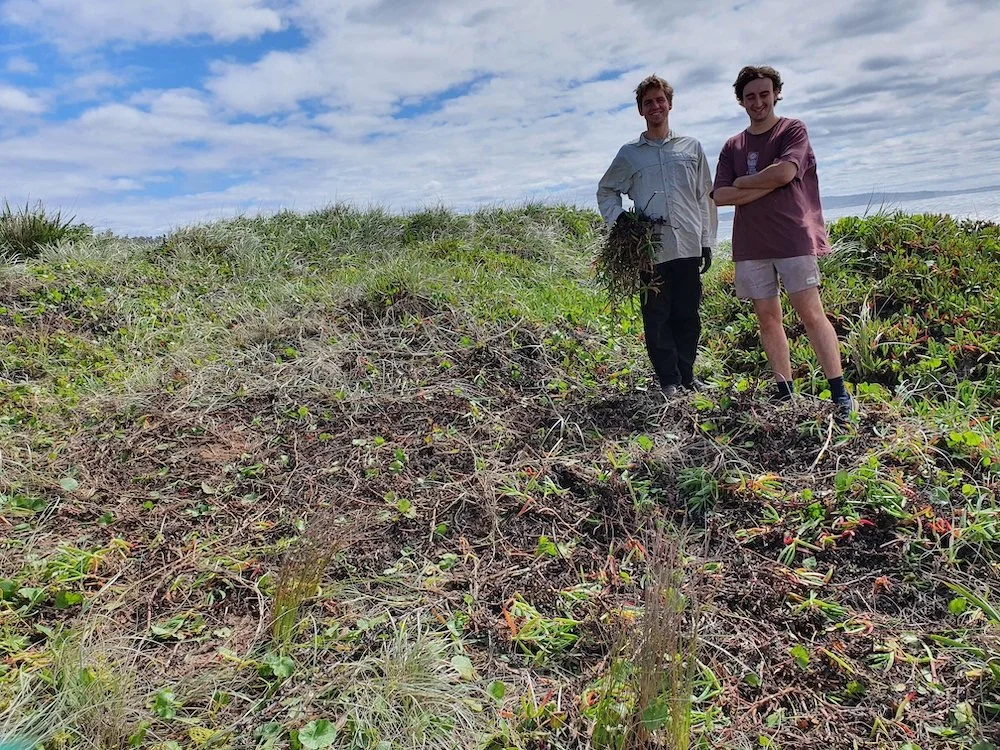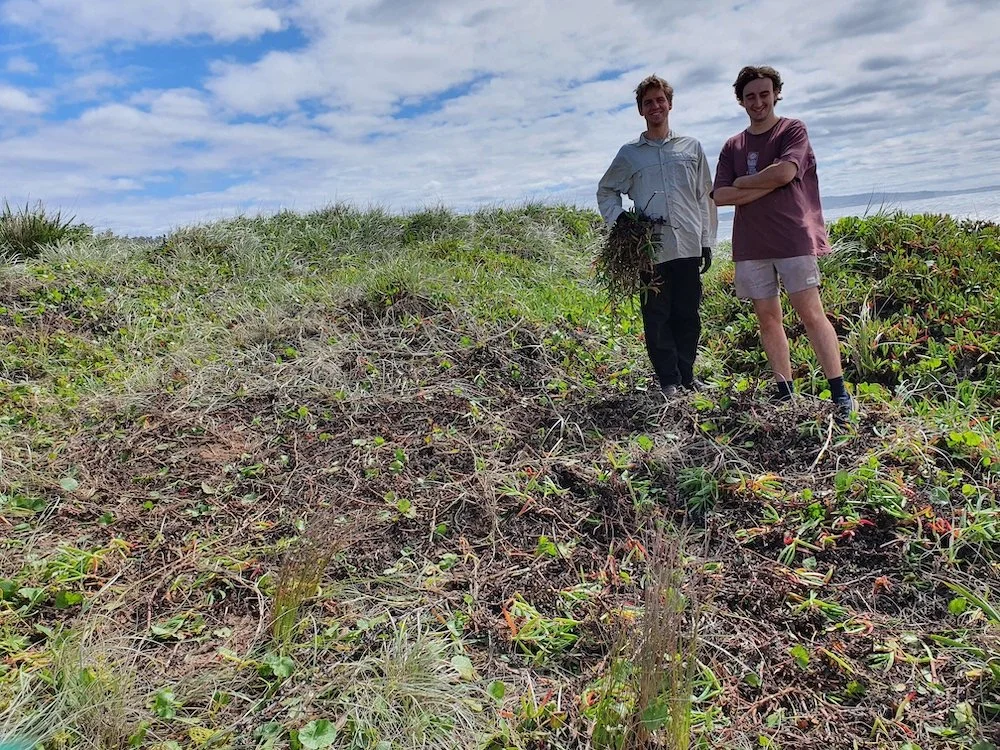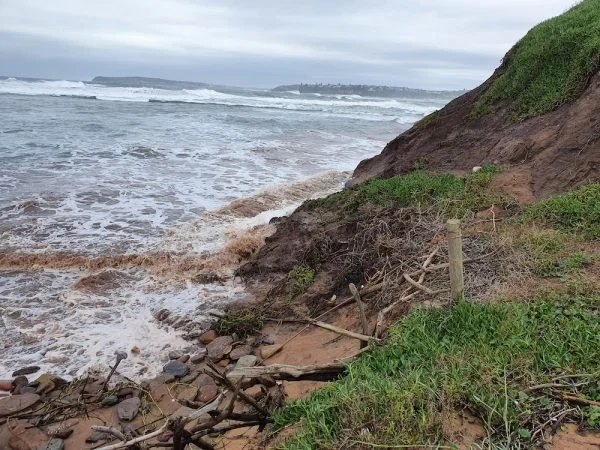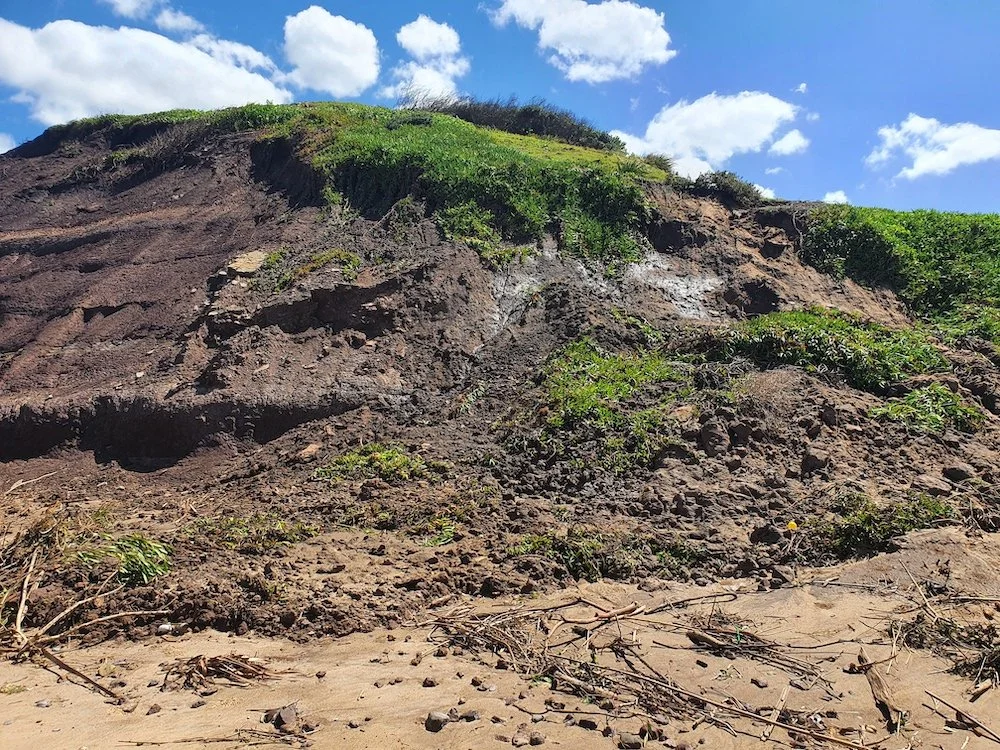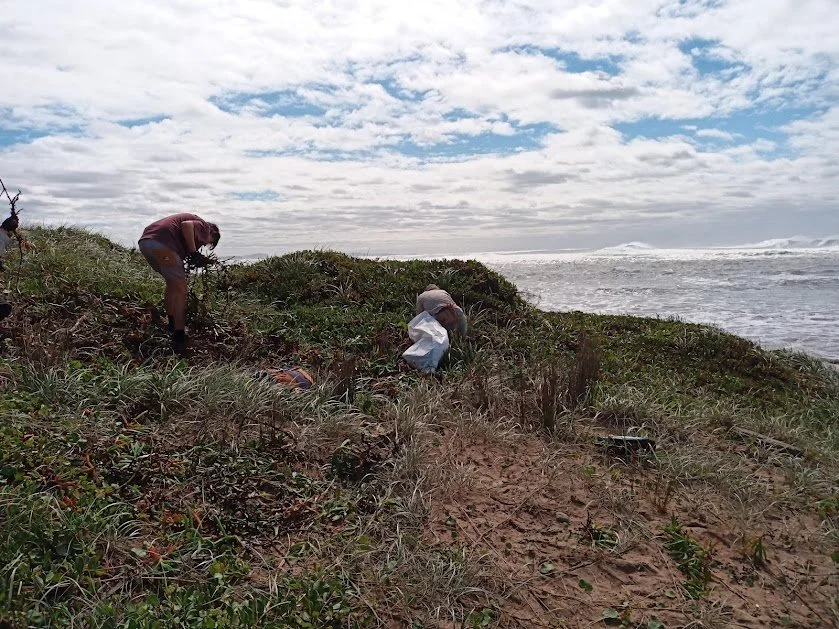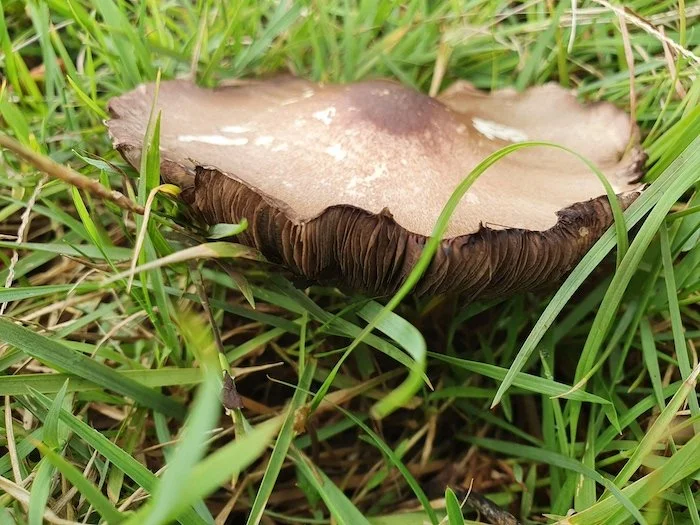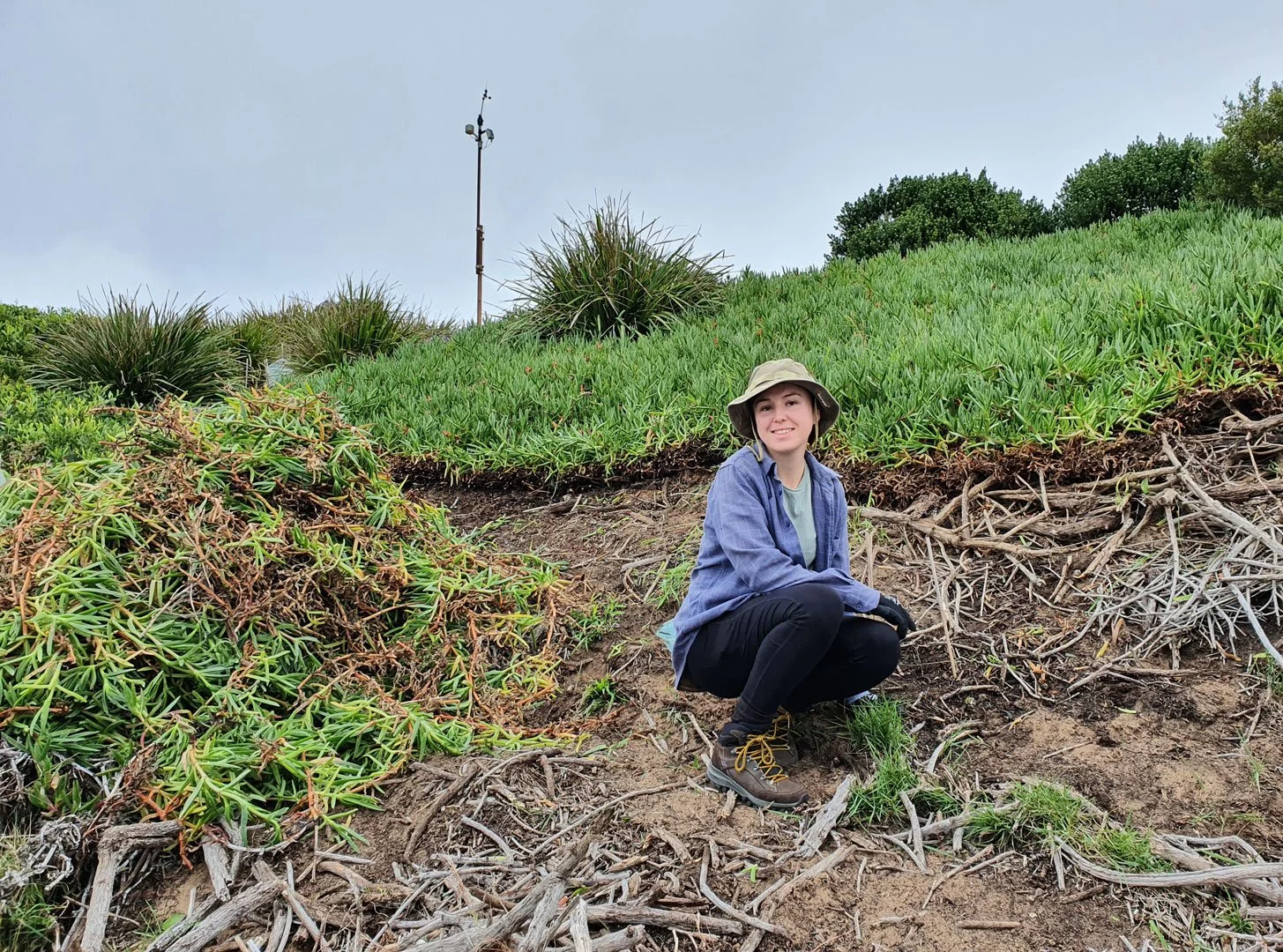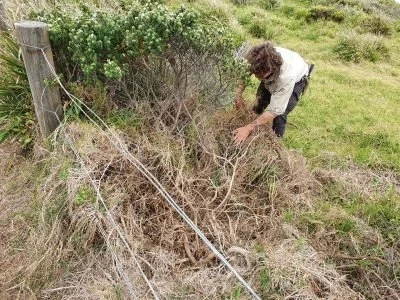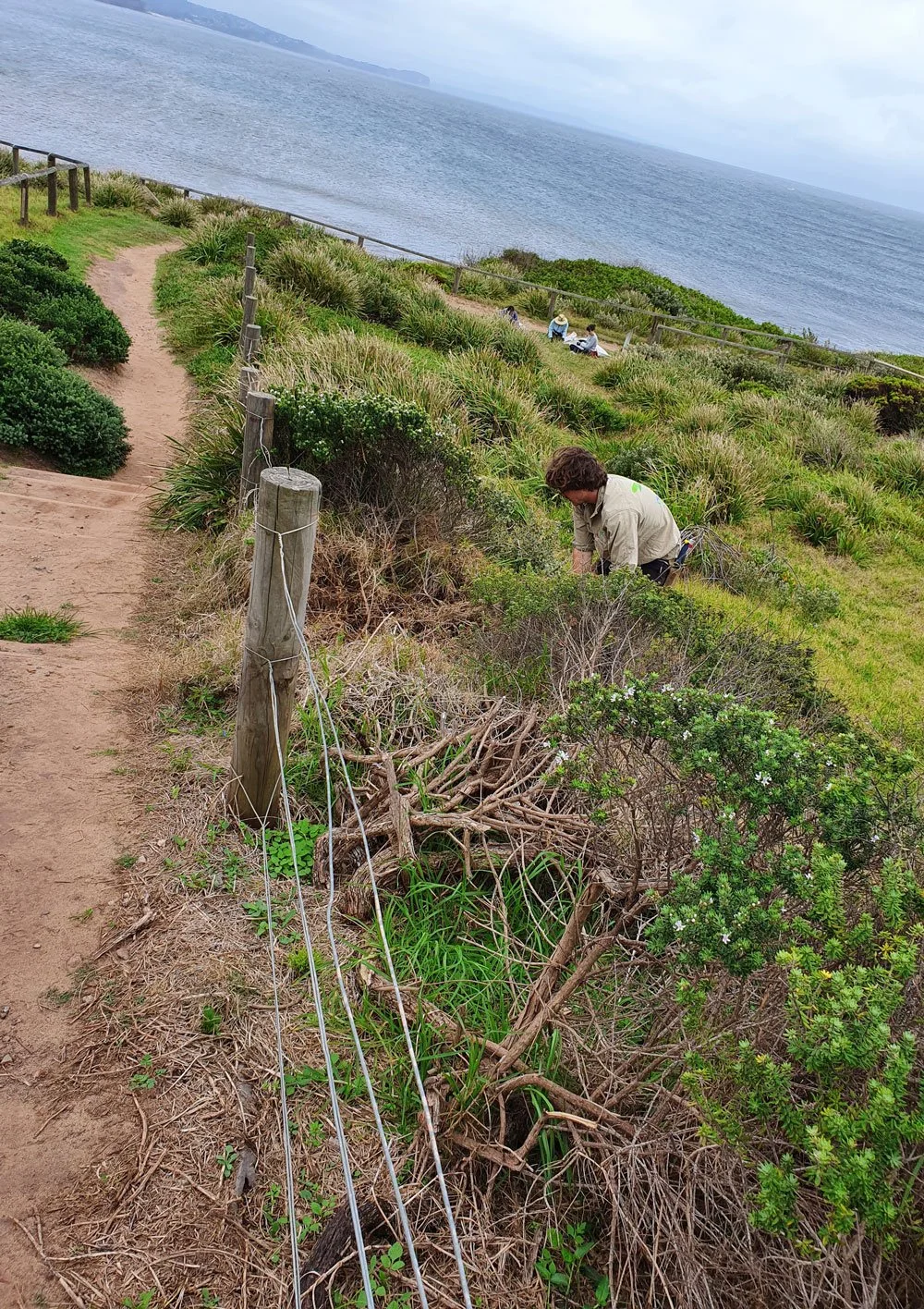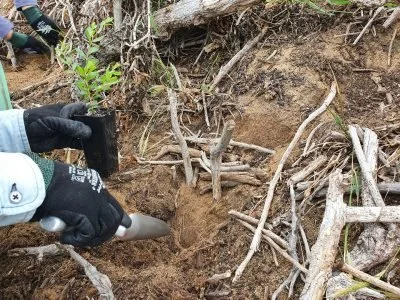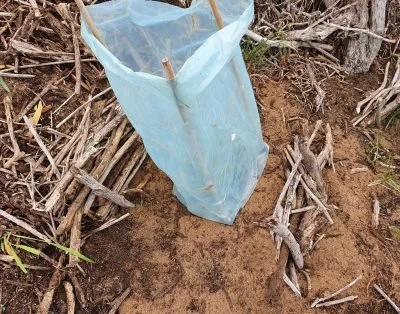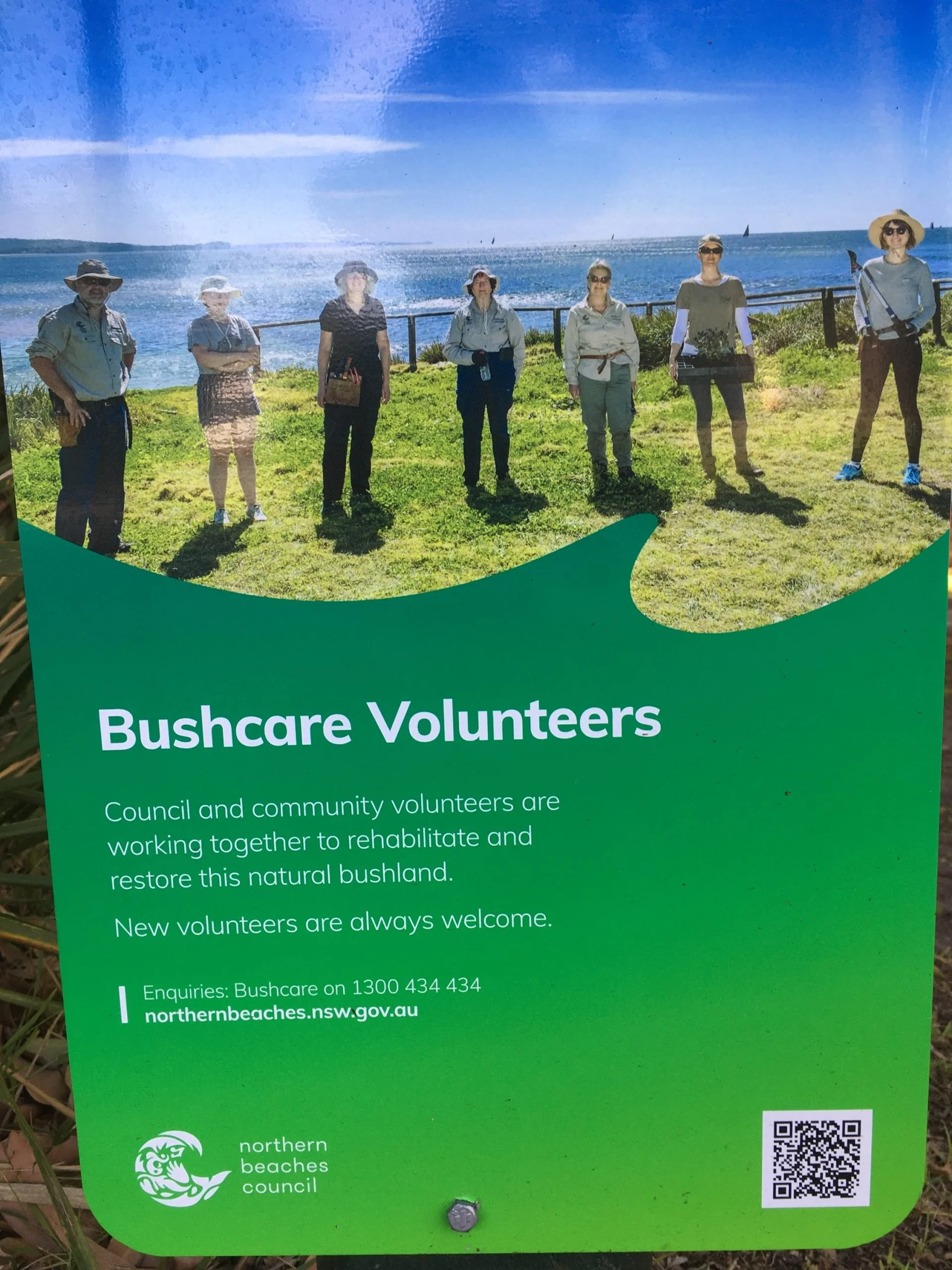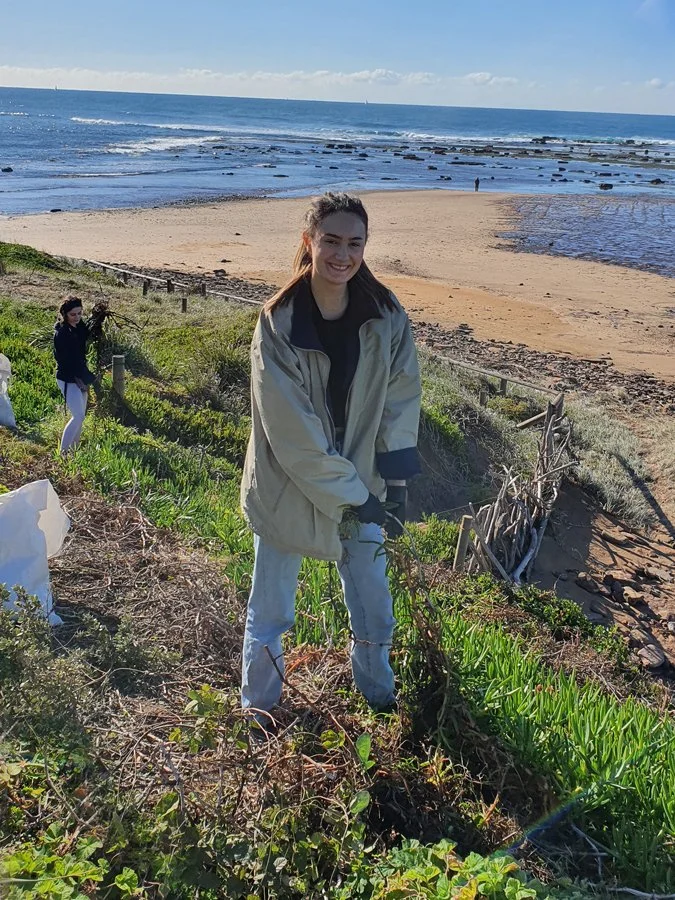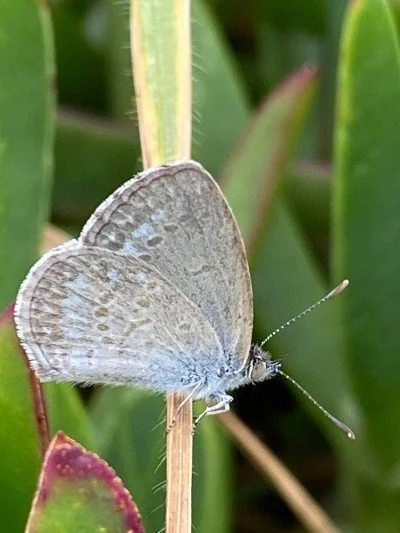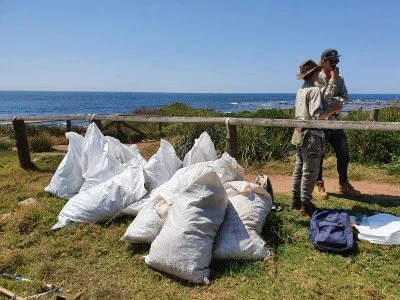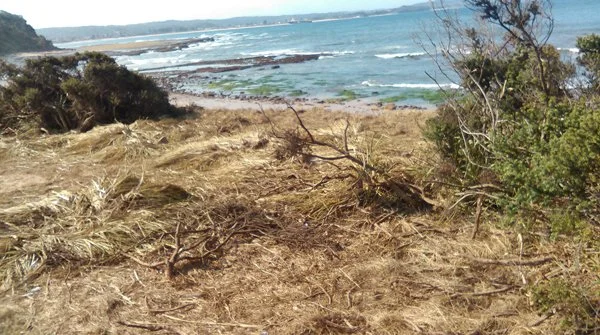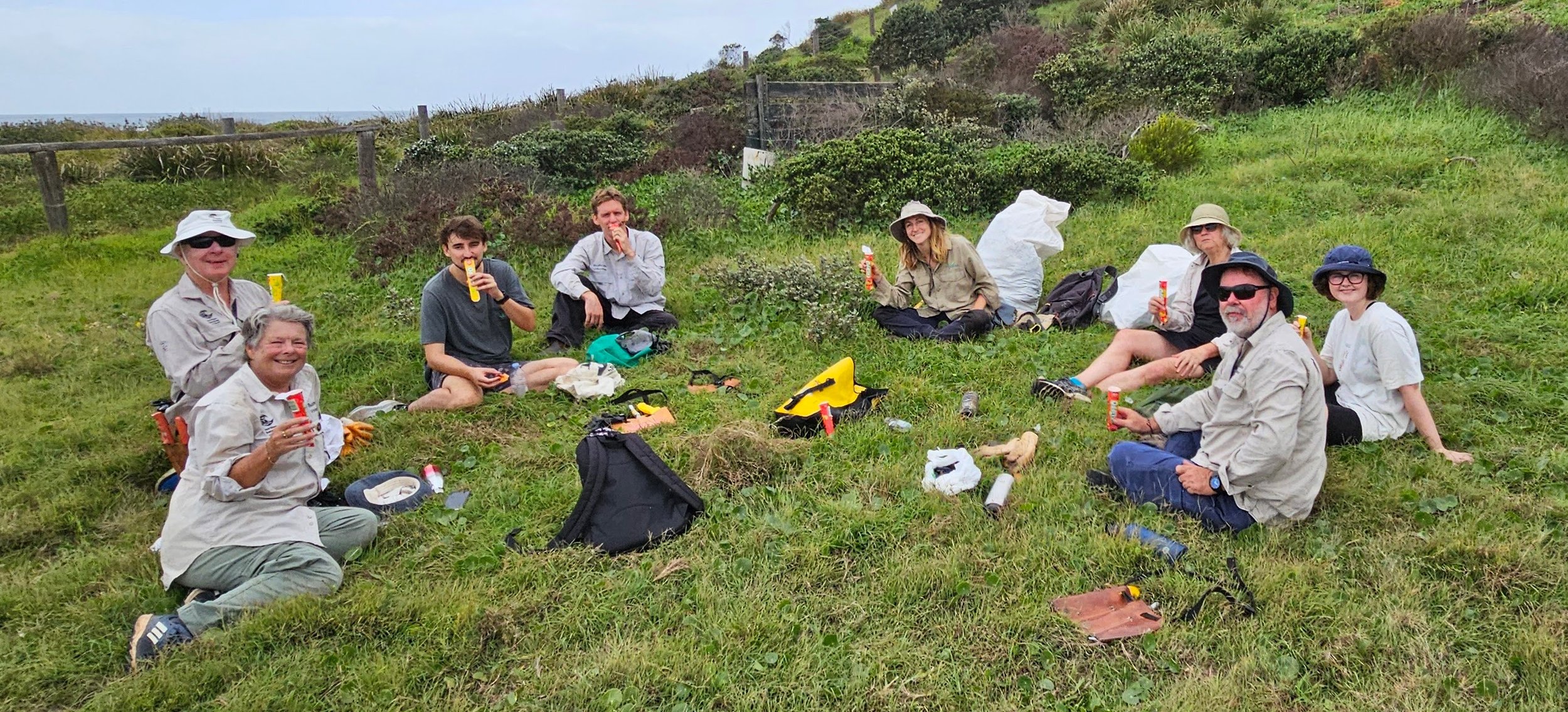
Blog
Reefcare Day Report: Protecting the Themeda grasslands
It was a beautiful sunny day for the twelve of us to work at beautiful Long Reef point….
It was a beautiful sunny day for the twelve of us to work at beautiful Long Reef point. Josh and Alex worked on removing the rest of the non-native Pigs Face off the Themeda on the lower northern west part of the site. A number of us worked for awhile down the path targeting Parramatta Grass immediately next to the track, so that it doesn’t come down onto our site. Maria stayed longer on this task, and Julie targeted Asparagus fern. Brad and Gen worked on the lower west side on various weeds whilst John, Izzy, Jarrah, myself and latterly Maria worked around near the bottom of the track targeting Asthma weed, Bidens and Buffel grass. As Des was in isolation, Merrilyn took over his role and scouted around the sight for asparagus fern, collecting other weeds as she moved around the site – she had a significant amount of weed in her bag by morning tea, that’s for sure.
At morning tea, Brad pointed out all the dead trees we had in our area, which was quite a shock. Jarrah said that he had seen this on another site, and that perhaps this is due to the amount of excessive rain that Sydney has experienced this year.
After morning tea Merrilyn, Gen and I did some planting in the eastern dunes as we had about half a dozen each of Lomandra and Kennedia (Coral pea) tube stock, whilst Alex and Josh also worked in this area on the non-native pigs face until they had to leave early for soccer. The previous areas cleared of the non-native pigs face are doing well with plenty of spinifex moving in as well as native geranium. Brad and Izzy attacked a large patch of Turkey Rhubarb up the top of the south bank (which Brad found), and unfortunately had seeded quite a bit, but they were able to get a lot of seed that was still developing. Izzy told me at the end of the day… ‘it was the worse job ever!” John, Jarrah and I were going to start on the Kikuyu along the northern sand dunes, but low and behold Jarrah found a Turkey Rhubarb, well into and under a large lomandra longifolia just east of the track – it was very difficult to get in there and get the buried red bulbs, we really needed a wombat.
As we didn’t get to start removing the Kikuyu from the Lomandra along the northern sand dunes, I’ve promised Jarrah, this will be our priority for next month.
Reefcare Day Report: Checking the wave damage after the storm
The waves were massive and we were all in awe of their size, power, strength and stunned at the damage that they were doing to the coastline and our site …
Alex and Josh working on the non-native pigs face.
Despite having a week of non-stop rain, like last month we were lucky and go in our full 3 hours of work – not only that, we had morning tea in sunshine. The waves were massive and we were all in awe of their size, power, strength and stunned at the damage that they were doing to the coastline and our site – which is now several metres smaller in a number of areas.
There were eight of us with three (Brad, Alex, Josh and Jarrah) working on removing the non-native pigs face just west of the flat area which was growing over a beautiful stand of Themeda. Des walked the site weeding and looking for his favourite weed – asparagus fern. Three of us (John, Claire and Lisa) weeded just west of the main path targeting Bidens and asthma weed.
After morning tea, we walked around the site to look at the wave damage and picked up two bags of foam which had come in from the waves, and the large pieces we left in a pile, where the Monday litter group put their collection of flotsam and jetsam for the Council to collect. On Monday morning one of our members with the hand of some casual beach uses cleared all the logs and other foliage on the sea side of the path, they did a great job.
After the groups tour of the site and picking up all the foam pieces, we all removed some of the non-native pigs face from the eastern sand dunes where there isan underlying cover of spinifex – which should help this grass establish better in this area.
Erosion SE Corner – this show the landslip that occured a few weeks ago
on the South East Cliff, where Reefcare lost about 1 to 2 metres of our
site down the cliff.
Erosion SE Cliff – this shows the water on Saturday – right up to the
cliff and scouring away the soil from the landslip a few weeks ago.
Erosion SE Dune – the waves were so large, that they were coming up and
into the eastern sand dunes. Normally there would around 3 metres of
sand between these dunes and the ocean
Erosion SE Corner – this show the landslip that occured a few weeks ago
on the South East Cliff, where Reefcare lost about 1 to 2 metres of our
site down the cliff.
Part of the group heading down the track to our work area.
The photo was taken by John Isles
clearing of the non-native pigs face.
Claire and Lisa weeding for Burr Medic and asthma weed
Reefcare Day Report: A break from the rain
Sydney has had weeks of non-stop rain, but miraculously – we had Saturday without a drop …
A break from the rain and a pleasant morning tea.
ydney has had weeks of non-stop rain, but miraculously – we had Saturday without a drop. But my gosh, it was tremendously humid. Despite the weather we had a great turn up of 11 volunteers plus our supervisor.
In the morning, Elias our supervisor for this month from Dragonfly Environmental along with Josh, Alex and Rohan removed more of the non-native pig’s face on the steep south western slope, whilst Claire, John and Issy worked on the flat targeting weeds, but mainly burr medic. Des, Brad and Merrilyn all worked on the western side removing more bitou. Des and Merrilyn had around a dozen plants – mainly creepers to plant around the area.
Julie worked over near the old creek removing bitou and planting around 30 banksia cones – so here’s hoping we may get some banksia seedlings coming up.
After morning tea, Issy and Claire collected some small Warrigal green (Native spinach) from the lower south slope to the west of the track which has absolutely flourished in the past few months with all this rain, and then went up the western slope planting in the area cleared with pigs face, and also where Des, Brad and Merrilyn had cleared bitou. So, we have 3 species of creepers and Warrigal green to cover this steep slope, which I am sure will prevent erosion. Alex, Josh and Rohan went to the bottom of the western slope and worked on removing Bitou in this area – as I say – heading west, bit by bit. Lisa and John went up to the steep south eastern end of the site and did general weeding and removing mainly in this area, Burr Medic, Ehrharta erecta, and bitou seedlings plants. This area is doing well, as we have many self seeded natives in this area which is reducing the weeds. couch and winter grass will be a target in the future when we get time.
Th wet weather encourages the mushrooms.
Reefcare Day Report: Beating the rain for a nice morning of bushcare
Reefcare had a fabulous turn up of 12 volunteers, which was fantastic given the inclement weather…
Arriving on site in inclement weather.
Reefcare had a fabulous turn up of 12 volunteers, which was fantastic given the inclement weather… we were actually getting organised with equipment with Jarrah from Dragonfly Environmental when we had a slight downpour, for which volunteers just put on their raincoats – what Trojans we have in our group!
Not a snowman, but a pigs-face-man!
Luckily it was only a 10 minute or so rain cloud and the rest of the day was fantastic. There was a pretty strong southerly, but working on the north side of the ridge this did not cause any problems. There was diverse working on site with a number of us (Izzy, Ivana, Claire, John, Josh, Maria, Jarrah and myself) working on getting rid of the non-native aggressive pigs face on the south western side, leaving hopefully a base of deceased pigs face as erosion control and then vegetation matter for mulching we cleared a large area and put in some tube stock – and then we planted about 8 plants (which takes time as we need to build our terraces due to the sandy steep slope) before moving down to the bottom where Ivana and Josh tackled a couple of Bitou, whilst Izzy, John, Claire and I worked on Burr Medic and Jarrah and Maria along the track working mainly on Bidens and other weeds.
Pigs Face removal prior to then doing some planting in this area - photo by Lisa Calder
Julie worked on the high west slope on Bitou, whilst Des was also in that area planting. Merrilyn and Gen worked slightly lower than the big group targeting Bitou seedlings, general weeding and they had 6 plants for their area. Six of us met at the Outpost coffee shop in Ocean Grove afterwards where we chatted on a wide range of topics.
Coastal Rosemary seedling
The photo above of coastal rosemary shows that with good terracing (old branches of the removed bitou) and mulching – on this steep sandy slope that the plants can do really well and it is easy to see the green shoots and how this Coastal Rosemary is growing. This was planted in December – 2 months ago and still looking good on this steep slope.
Reefcare Day Report: Perfect weather for planting
The BOM (Bureau of Meteorology) predicted rain – but thankfully, they were wrong as usual.
After removal of the non-native pigs face (see pile on left of photo) we have cleared the ground for planting. We make a long trough and ensure any rain water from uphill, will come into our planting area.
The BOM (Bureau of Meteorology) predicted rain – but thankfully, they were wrong as usual. The Saturday was a cloudy day with quite a bit of wind which made it fun trying to put weeds in the weed bags! But a perfect temperature for working on our site. We had 60 plants to put in on the western side of the site which is very steep, and therefore involves some landscaping, in places – with almost building terraces for our plants so that they are stabilised in the cliff after planting and that rain water will move into their trough which we create in the appropriate space on site.
Half the group worked on one area on the southern western side some worked in the gully area where we planted the five Goodenia dimorpha as it’s a bit sheltered there, the other plants were planted on the western side where they planted some coastal tea tree, Hibbertia scandens, native rosemary, banksia, Melaluca Amillirs.
Jarrah working along the fence line removing the Kikuyu from the fence and the native plants along side. This clearing we have tried to do for over 2 years, but due to seasonal invasions this just constantly got put on the back burner – with unfortunate consequences – it has spread into some really good Themeda grassland on the eastern side of the track, which now looks like a weed mass instead of 5 years ago it was just delightfully full of colour at seeding time with that beautiful sienna colour.
Six of us on the southern western side unfortunately had to spend the first hour removing the non-native pig’s face which had grown down the slope to the proposed planting area – a few months ago, this area was clear, but the non-native
pigs face is a very aggressive grower having engulfed previously planted plants from last month; unfortunately none of the Isolepis nodosa plantings survived being covered by the pigs face. The past amount of rain we have had, the non- native pigs face has literally exploded, it’s now becoming a problem as big as the Bitou. Such ashame as Peter Miller spent so much time ensuring we only had the native pigs face on site… alas, it was not so….
More Kikuyu clearing
After Morning tea the six who had worked on the steep slope then worked on the eastern flat removing the Bromus grass which has come onto our site as it has moved down the public path way which is Council responsibility – we did ask last year if Council could get contractors in to remove, but this did not happen. We have asked again this year.
Reefcare advised Council of this weed issue 3 years ago.
Our wonderful supervisor spent the latter morning continuing to remove the kikuyu from along the track fence line and off the native plants – it’s really looking good along there now thanks to Jarrah – as you can see from the photos.
The bulk of other team members moved back up to the western slope to finish with the plantings, removing bitou and weeding as they headed west, whilst two members – Merrilyn and Gen, went around the site targeting a Gladiolus which appeared about three years ago. Georgia Williams from Council advises that is it “most likely a hybrid but similar to Gladiolus caryophyllaceous”. This does need to be targeted because if left will spread over bushland and impact plant communities – given the number of seeds around the corm and also the amount seeds in the pod after flowering, I can certainly see how a few of these could quite quickly become more than many – what an amazing set up for over propagation.
As the slope is so steep and the basically sandy soil can readily collapse, we create a mini retaining wall above the trough, (see the use of the previously cut Bitou to create this retaining wall) then did a hole for our tube stock plant in front of the retaining wall.
The retaining wall completed and the plant in the ground, which mulch around the plant and in the created trough. We have found that my mulching around the plants we there is a much better survival rate, as this is protecting the sand which gets very
After planting a plastic guard is put around the plant to not only protect it from rabbits, but it help keeps the moisture with the guard so that the plant does not dry out. Once established, the guard is removed.
Reefcare Update: New Reefcare Sign
Just want to let you know that we Reefcare have been immortalised on Northern Beaches signage!
Hi all,
Just want to let you know that we Reefcare have been immortalised on Northern Beaches signage!
Julie found this sign this week on the Anzac Reserve site – on the northern end of Jamieson Parade.
Reefcare Update: Some old photos to share
Throwback! We have come across some photos from 2008-2012 we’d like to share.
Throwback! We have come across some photos from 2008-2012 we’d like to share.
Reefcare Day Report: World Environment Day
One of our Reefcare volunteers – Josh, who is at university works part time at Ben and Jerry’s ice-cream shop in Manly, had very kindly suggested Reefcare as a group for Ben and Jerry’s to participate in for World Environment Day.
Morning tea and enjoying the wonderful supplies from Ben and Jerry’s – the cookies and icecreams.
One of our Reefcare volunteers – Josh, who is at university works part time at Ben and Jerry’s ice-cream shop in Manly, had very kindly suggested Reefcare as a group for Ben and Jerry’s to participate in for World Environment Day. Hence our group were privileged to have Ronnie and Brigitte for the morning. Not only that, Josh arranged for some amazing biscuits and ice-cream from Ben and Jerry’s for the group to indulge in for morning tea.
Northern Beaches Council arranged for an extra Supervisor and tools – as not only the two staff from Ben and Jerry’s we also had two new volunteers for the day, Keisha and Sacha who are undertaking their Duke of Edinburgh. So Reefcare had Matt from Tooligoona and Emmie as Supervisors.
Alex attacking Bitou Bush
The group met at 8:30 so that a Site Introduction by Emmie could be completed for all the new volunteers – which was great, as Reefcare had a few members that had not completed the site induction program.
Keisha, Sascha and Emmie removing Bidens, Asthama weed and erharta oin the western side of the bottom track
Emmie with Keisha and Sacha worked on Bidens, Burr Medic and Asthma weed and Ehrharta just on the western side of the track toward the bottom (we have worked here at this site for the last 5 months – we are getting there are there were certainly far less weeds there this month) – when this was completed, they started to work on some of the early arrival of Burr Medic on the eastern flat next to the track near the Birds of Longreef sign.
The crew on the western slope removing Bitou Bush
Myself with Ronnie and Brigitte worked on the middle flat on the eastern targeting Burr Medic (left more than enough for Keisha ns Sacha for follow up work) and then moving up to the eastern edge heading south, removing the non-native pig’s face back from the Themeda and removing the underlying erharta.
Then there was the western team – Brad lead the planting for the gully with the plants designated for this area, and then joined the rest of the team heading west to get rid of the Bitou. Merrilyn spent a lot of time targeting thistles. In this area working we had Des, Brad, Merrilyn, Gen, Josh, Alex and Michael.
Ronie and Brigette on the eastern slope removing the non-native pigs face off Themeda – Kangaroo Grass
Ivana, Emma and Donya cleared some non-native pig’s face on the top south western slope and then planted about 10 tube stock into this area. They then worked on Burr Medic.
Morning tea was very special today thanks to Ben and Jerry’s supplies which Josh brought along, with included four flavours of ice cream – triple caramel chunk, chocolate fudge, strawberry cheesecake and cookies and cream as well as some chocolate fudge brownies and choc chip cookies. How spoilt were we! Thank you Ben and Jerry’s.
After morning tea Brad, Gen, Josh, Alex and Michael all continued to work on Bitou removal, Merrilyn removed thistles whilst Des roamed the western
site pulling out small seeded Bitou.
Ivana, Emma and Donya worked on Burr Medic removal just past the line of Lomandra on the north western side and then moved over to the eastern where we worked last month, removing non-native pigs face off the spinifex. The work from last month is looking really good, so we can continue in this area next month.
Morning tea
Morning tea with Ben & Jerry’s ice-cream
Reefcare Day Report: New supervisors and the work continues
This month we had a new Supervisor Matt from Toolijoona ..
Morning tea on a beautiful day
This month we had a new Supervisor Matt from Toolijoona – as our usual supervisor Claire Cashel from Dragonfly Environmental, was on rest having sprained her back, – but Matt Ziegler was great step in, having worked close to this area weeding around the pathways of Long Reef to Dee Why, so was familiar with our native plants and weeds and what the local weed issues were.
Before Morning tea, 3 of the team, Des, Alex and Rohan (his first working bee with Reefcare) as it happens we Rohan and I are both members of the Northern Beaches Branch of The Wilderness Society – worked on the high western slope removing Bitou as we continue to move west across the slope. The plants from last month look like they have an 80% survival rate which is really great; it’s such an exposed area.
Two of our group, Ivana and Donya worked on Bidens, Burrmedic and Asthma weed just on the western side of the track (we have worked here at this site for the last 4 months – hopefully we will get there and have no weeds) whilst myself with Elaine worked on the eastern dunes adding mulch to last month’s plantings, watering and then getting rid of the non-native pigs face in areas where we had good ground cover of spinifex, native geranium, Isopolis and Lomandra. Matt worked on the eastern dune area for awhile and then went up the western slope with the Bitou clearers.
We have a lovely break at morning tea as it was a nice temperature and sunny – so nice to get together and just chat.
After morning tea – Des went up the western slope to continue attacking the bitou, whilst Alex and Rohan attack the Bitou on the northern eastern side – Alex was very keen to work there having started last month in the area and was very keen to finish – which he did! Well done Alex and Rohan. I could see they were pretty pumped with completing this job! That’s so great – it’s what Bush regeneration is about, seeing results for one’s effort.
Lisa, Elaine and Donya started on the eastern side and moved south as we removed pigs face off our natives, then burr medic, thistles, ehrharta erecta.
Des went back up the western slope whilst Alex and Rohan completed the removal of the Bitou at the end of the track to the point.
With all the water that was brought we were able to water all the plants that we planted last month. There is only around 20% loss up the top – which is good for this exposed site, but there was 100% survival of all the plants we planted on the eastern side of the site. The big wells, mulch certainly help to increase the survival rate.
Reefcare Day Report: Working on the Easter Weekend
As this was an Easter break over this weekend, we did well with 9 volunteers being able to make the morning …
Planting and watering seedlings
As this was an Easter break over this weekend, we did well with 9 volunteers being able to make the morning – it was quite warm, almost no breeze and the ocean looking so peaceful, after the week of rough seas a few weeks ago when we had 5 days of torrential almost non- stop rain. But this rain had certainly penetrated our soil, and so this was excellent for the 80+ plants we managed to get into the ground. Instructions were given on how to plant, deep, ensuring if on a slope that soil is moved to try and capture the most water possible for next rain, mulch around the plant and a few old (previously cut) Bitou branches over the top of them, so that they get time to harden to the Long Reef point salty winds.
The 2 litres of water people brought for our new plantings will really help to them to get their roots into the new area. We didn’t quite have enough water with us, so Kim kindly went up to the water fountain after morning tea to get more water for our newly planted tube stocks. About ½ a tray of Lomandra was considered too immature to plant, so Claire C. has kindly offered to take them back to Dragonfly Environmental and look after them until next month, when they should be at a better size for planting out.
After morning tea, Des and Josh planted the last of the tube stock on the top north western slope (just down from the main track) where last month we had removed about a metre of the non-native Pigs Face from our native vegetation. After completing this planting of a dozen or so tube stock, Des and Josh joined Alex and Claire F, who were removing Bitou on the far eastern side. Ivana had to leave after morning tea after planting on the eastern sand hills with Claire C, Alex, Kim and myself. Julie continued her task of Bitou removal on the western slope – her favourite job; other than Watsonia removal at Griffith Park. Lisa, Claire C moved along the south eastern hill, removing the non-native Pigs Face off the established Themeda – and moving up the slope to the SE corner, removing non-native Pigs Face where appropriate to not cause erosion, Ehrharta, Summer grass (which has come onto site, due to spreading down the public path to Long Reef point), Buffalo grass, Burr Medic, a couple varieties of clover, flea bane etc. This area is doing well with the native geranium seeding and spreading and also Myoporum which has seeded amazingly well in this area – being in such a windy area, it is not in its usual scrub form, but hugging the ground.
All in all, it was an amazingly successful day.
Photos by Lisa Calder and Kim Marsh
Reefcare Day Report: A big turnout!
There was a terrific turn up for Reefcare today with 15 volunteers – in just the perfect weather for bush regeneration.
There was a terrific turn up for Reefcare today with 15 volunteers – in just the perfect weather for bush regeneration. Unfortunately, despite our request for specific plants for the gully, these were not provided, so the game plan for the day had to be seriously modified based on the plants provided (none of which were on the request list!).
Most of the group started at the top section just past the gate to Long Reef headland, removing the weed pigs face off the native plants and moving it back, so that there is room for the good plants to move in. A few Commelina cyanea tube stock provided and these were planted in a cleared pigs face area. So ½ the group worked on pulling up the weed pigs face whilst the rest were planting the themeda in a previously cleared area. Everyone brought 2 litres of water as requested for our new plantings.
With this completed the group moved down the slope to a previously cleared area which due to lack of plants being provided, had not planted out with Themeda –the weeds were Blackberry nightshade (just flowering and small green berries – so bagged before seeding!), thistles in flower and seeding, flea bane, which was seeding and Turkey rhubarb which had a lot of immature seeds and was just about to seed – good timing – this area filled about 3 weed bags.
We then had morning tea a little bit late – it was after 10:30, but it gave time for people to talk to one another and get to meet the two new volunteers, Josh and Alex. It was also a time to say good bye to Aurelie who’s work contract in Australia has expired and she is returning to France with mixed emotions, of loving Australia, but missing her family. Four were missing in the morning tea photo as they were working through, due to having to leave at 11:00 for other commitments. Kim joined the group for morning tea, as he likes to keep up with what we are doing, so that in the background he can support us, as much as physically possible. As we all know, we have 2 of Kim’s fences which have seriously assisted in erosion control and ‘trespass’ through our working area. In the last week he has also done maintenance on the public track to Long Reef point which was getting to the point of dangerous. I had reported this section of the track to Council about a year ago but there was no response = thanks to Kim, this part of the track to Long Reef point is much safer.
After morning tea the group was spread out with Elaine and Aurelie working back on the slope to finish off the weeding in that area, whilst Ivana and Claire F. worked on the eastern area targeting Burr Medic, whilst Jayke, Claire, Josh and Alex worked on the north eastern area on Bitou – and there were a couple of seriously big Bitou to eradicate in this area – and a few more left for next month!
Reefcare Day Report: Burr Medic and Bitou
There were just 8 Reefcare Volunteers this month arriving with very inclement weather …
There were just 8 Reefcare Volunteers this month arriving with very inclement weather, not knowing with the storm front coming across, if we would get 1/2 an hour of work 1 of work… as it happened we managed to have morning tea and work until about 20 to 12 – when we had some drops from the sky – we thought this was the front, so we left the site. As it turns out, we could have worked through this as it didn’t pour down until 12:30 when Des, Lisa, Julie and Aurelie were safely ensconced having a well earned coffee at the Outpost Café.
The usual four Bitou workers (Julie, Brad, Merrilyn and Gen) worked on the far western slope alternative time removing Bitou and weeds. Merrilyn is keen to target the Gladiolus species which is exceedingly time consuming, ensuring that all the little seeds of the main root bud are collected. This is a new weed on site as of last year with a single plant appearing on the sandy eastern part of our site about 3 years ago, so it’s rather surprising that it is now turning up in annoying numbers on our western slope. How did it get there – all over our western area?
Aurelie, Claire F. and I weeded an area on the western part of the path which had a lot of Biden’s Podesta which we have not had a lot of, so good to eliminate this weed which the seeds are viable for 20 to 30 years, we continued on this section to weed Blackberry nightshade, asthma weed and Ehrharta erecta. After morning tea, Claire worked on a big Asparagus fern along the track and then attacked some Bitou on the eastern edge of our site. Aurelie and Lisa worked on Burr Medic on the sand area east of the main track.
Reefcare Update: Canavalia rosea
This is very exciting for Reefcare, as we now found another new native plant on site since the first sighting of Clematis in September …
Beautiful pink flowers of the beach bean
Carnavalia Rosea Vine – 1st Time on Site
Lisa Calder – Reefcare Co-ordinator was wandering around the site this afternoon checking for the immediate work required for the next working bee due Saturday 6 February, 2021 – (Reefcare had not attended the site for two months, as they do not work the first Saturday of the month in January) and found a vine with a beautiful pink pea shaped flower – it was quite a size and had a number of ‘beans’ – so hopefully this will generated into new plants of Canavalia rosea. Thanks to Catriona Wagg from Northern Beaches Council who was able to identify this plant from Lisa’s photo.
This is very exciting for Reefcare, as we now found another new native plant on site since the first sighting of Clematis in September, 2020 – and we are hoping maybe Catriona will be able to propagate from this plant and Reefcare will have a couple more of this native species on site.
Canavalia rosea is a species of flowering plant of the genus Canavalia in the pea family, Fabaceae,
Common names include beach bean, bay bean, seaside jack-bean, coastal jack-bean,[1] and MacKenzie bean.[2]. Wikipedia – https://en.wikipedia.org/wiki/Canavalia_rosea
Scientific name: Canavalia rosea
Order : Fabales
Genus: Canavalia
References
^ Jump up to:a b “Canavalia rosea“. Germplasm Resources Information Network (GRIN). Agricultural Research Service (ARS), United States Department of Agriculture (USDA). Retrieved 2010-12-04.
^ Jump up to:a b c d Christman, Steve (2004-01-14). “#857 Canavalia rosea“. Floridata. Retrieved 2010-12-04
Reefcare Day Report: Blue butterflies
We were lucky that the temperatures were in the low 20’s …
Common Grass-blue from the tribe Polyommatini. Photo by Claire Cashell
We were lucky that the temperatures were in the low 20’s, but there was some humidity so we were a little uncomfortable all wearing our long pants and long sleeved shirts and boots = oh, arrh… the price we are prepared to pay to make Long Reef point beautiful.
We had 3 people working on the Bitou on the high western slope, and they weeded as they went along, few thistles still around, Ehrharta, hundreds of Bitou seedlings – and a weed Gladiolus species which had appeared on site a few years ago in the eastern sand dunes and is now being found on the high western slope, the flower is a lovely pink colour with hints of mauve, but to remove takes a lot of time (around 15mins per plant) as around the main bulb/corm are dozens of little white seeds, all of which need to be collected. This weed originates from South Africa, is classed as a garden escape and can spread by the wind. It can become extremely problematic like Watsonia, so it is important to remove the ones we find on site as fast as possible.
Three of the volunteers concentrated in an area alongside the eastern part of the track, targeting Bidens pilosa (also known as cobbler’s pegs and for some weird reason, Farmers Friend!) where most plants were just forming those horrible seeds, but a few plants were more advanced. Is thought this weed originated in tropical America.
“….It is also regarded as an environmental weed in New South Wales, Queensland, Western Australia and the ACT. It is considered to be among the top 200 most invasive plant species. This species is readily dispersed by man’s activities and dense populations can out-compete native species on the exposed margins of bushland and in revegetation sites.” [1] There was also some flea bane, bitou seedings and that horrible asthma weed Parietaria Judaica – The leaves and stems are covered in curled hairs that feel sticky and as it’s life cycle can be 2 – 3 weeks and we come monthly, it will take some time get rid of this weed. The Turkey rhubarb keeps appearing where we initially cleared it a few months ago, but it is slowly getting less in that area – we just have to keep at it each month. One volunteer scouted the eastern part of the site for flea bane, and another worked on bitou removal on the north eastern sand dune.
Des scoured the site for Asparagus fern which he also did last month and had a bag full by morning tea. And talking about morning tea – we were like excited children in a school yard – there were so many of the small blue butterflies all over the site, it was very beautiful to see and rather exciting. Everyone was talking of them during morning tea. We are lucky as one of our members is studying entomology at University, and Genevieve Law was able to identify these as the Common Grass-blue from the tribe Polyommatini. Gen Law wrote ….These butterflies look like Lycaenidae (‘blues’) – they are generally quite small, somewhat furry and grey/blue in colour. They are often cryptic at rest, and you often can only see the blue colour when they open their wing.”
The butterflies have an interesting white spot on the club of the antenna
The butterflies have an interesting white spot on the club of the antenna – which can be seen in the great photos taken by Claire Cashell our site supervisor from Dragonfly Environmental.
We spent some time at morning tea also discussing our plans for the work on the site for 2021 –Claire Cashell will report our plans to Northern Beaches Council as required.
After morning tea most went back to their favourite spot, but three moved to the eastern dunes, targeting kikuyu, seasonal weeds and on the far eastern side removing pigs face off Themeda and Ehrharta.
https://keyserver.lucidcentral.org/weeds/data/media/Html/bidens_pilosa.htm
Reefcare Day Report: Weeding in the sun
It was a beautiful warm sunny day at Long Reef, around 23 degrees, with just a slight light breeze, being slightly more on the western slope for which the Bitou clearer s were very grateful.
It was a beautiful warm sunny day at Long Reef, around 23 degrees, with just a slight light breeze, being slightly more on the western slope for which the Bitou clearer s were very grateful. How lucky are we working in this area of beautiful scenery. There were quite a few planes today and lots of para gliders were out. We saw Osprey and the local Nankeen Kestrel spent the whole time around us – at morning tea it caught a feed about the size of a mouse on the lower western slope near the track, and later in the afternoon the Kestrel flew over two groups of us, not more than a metre – amazing! thought I could put my hand up and touch this magnificent bird with these really beautiful colours.
The four Bitou workers on the far western slope – Julie cut and poisoned some Bitou on the top area of the western part of our site. Brad, Gen & Merrilyn worked below Julie continuing to move west and eliminating two big clumps of Bitou. They also removed quite a lot of Burr Medic. The big success of the day was Brad finding Des’ previously lost knife!
Claire C. and Jayke worked on Burr Medic, Bromus and oat grass at the bottom, along the path – whilst Elaine was targeting the same weeds in the eastern flat area.
Ivana, Des and Lisa all tackled the Burr Medic on the western flat – where there were also quite a lot of thistles, which we managed to eliminate in this area. There is so much of this, that even in this one area we only removed about 50%. It is on the turn from green to brown burrs. In some places we could have done with a dustpan and brush for all the burr seeds that have fallen. The lot near the track have all seeded, we were too late for that. We really could have done with 3 times the number this month, but due to COVID, NBC are still restricting us to 10 volunteers. I am seriously worried about next year with this weed if NBC are unable to poison again.
Image 1: Group photo at morning tea
Image 2: Bitou clearers on the far western side of the side
Image 3: Clearing the burr medic- some of them are huge
Image 4: Our Weed bags at the end of the day
Reefcare Update: Clematis on site
low and behold on the eastern side at the bottom of the track, we have our local native clematis – this is the first time in 25 years I’ve seen this actually on our site!
I was wandering around our site this morning just checking out the work done by the contractors on the Burr Medic – and low and behold on the eastern side at the bottom of the track, we have our local native clematis – this is the first time in 25 years I’ve seen this actually on our site!
Think this is very exciting, a new plant on site and it’s not a weed!
Clematis aristata, known as Australian clematis, wild clematis, goat’s beard or old man’s beard, is a climbing shrub of the family Ranunculaceae, found in eastern Australia in dry and wet forests of Queensland, New South Wales, Victoria and Tasmania. Wikipedia
Scientific name: Clematis aristata
Rank: Species
Reefcare Day Report: A perfect day for bush regeneration
It was a beautiful warm sunny day at Long Reef, around 21+ degrees – with just a slight light breeze – a PERFECT day for bush regeneration at Long Reef.
It was a beautiful warm sunny day at Long Reef, around 21+ degrees – with just a slight light breeze – a PERFECT day for bush regeneration at Long Reef. What a wonderful place to work and all were in a light hearted happy mood. The morning was made very exciting with 3 Osprey flying around near us.
The four Bitou workers – Julie, Brad, Gen & Merrilyn, continued to slowly move west, high up on the hill, but also as they moved along, they removed as much of the thistles which are flowering and some ehrharta as possible, (we need an army battalion to get anywhere to eliminate the ehrharta on site!) Filling 1.1/2 bags of weeds by the end of the day.
Judith worked on removing Bitou seedlings in the eastern side toward the primary dune; whilst Claire C. worked on thistles along the path. Lisa, Claire F. & Ivana did a follow-up in the area last month where we found Turkey Rhubarb endeavouring to clear the area of tubers and bulbs. We are pretty sure we will need a follow up in the area again next month. This took much longer than we thought and worked there until morning tea.
About 10:30 Council’s appointed photographer on a special assignment to obtain some action shots of volunteers and some shots of some of the bush regeneration beautiful sites on the Northern Beaches, which they can use for promotion material arrived – so Andrew got a few photos in before we stopped for morning tea. He then did a few group photos with the sea in the background for some and the grasslands slope in the others. After morning Andrew, moved around the site from the Bitou workers high up on the western slope and then those of us weeding on the flatter areas – and was with us until we finished at 12:00. Other sites he visited on Saturday were North Harbour and Mona Vale Basin.
After morning tea, the Bitou people took the dozen or so plants up to their area to plant (there was Westringia – coastal rosemary and Correa Alba), as the initial planting site where the Turkey Rhubarb was, will need another follow up, and we would be best with Themeda for the area anyway.
The weeders were going to clear the Kikuyu on the eastern side of our site – but once again, we had a higher priority – the thistles which are in the process of flowering. We no way got this finished, so didn’t even get to attack the asthma weed which we worked on last month.
The Burr Medic is out of control on our site, and Reefcare volunteers do not have the numbers or time to tackle this horrible annual weed. NBC were going to poison, but as soon as the signs went up about using poison, the Council were inundated with complaints from the public about using poison – I have requested Council organise a day with ACV (Australian Conservation Volunteers) to target this weed as soon as possible, as it already has green burrs, and it won’t be long until they turn brown and set a million seeds for next year.
There is also gazinea heading down the slope, so this will also need to be tackled sooner rather than later, so that it’s not a future problem on our site.
Reefcare Day Report: Bushcare during covid
Due to COVID-19 Reefcare was still only permitted to have 10 volunteers on site.
Due to COVID-19 Reefcare was still only permitted to have 10 volunteers on site.
As last month all required procedures were undertaken which included sanitising bush tools before and after work, working at least 1.5m apart and bringing of our own morning tea, due to no sharing of food or drink.
It was a beautiful sunny day, just perfect for working and we constantly had the Nankeen Kestrel hovering in and around us over the grassland, busy looking for food. Once again we also had our mother and baby magpie circling us at morning tea looking to tip bits. They often where we are working and when leaving a spot, they dive in to the fresh soil for an easy meal.
We had three of the group working on the top north west slope removing a lot of Bitou seedlings, and bagging any other seasonal weeds, such as thistles which have been prolific this year, as well as some Bitou removal as we slowly move westward. Further up the rise another volunteer was working in a previously worked area where Bitou had been cut back, but had not been previously poisoned.
Two volunteers were on the southern east slope of the site, once again, targetting Bitou seedlings and bagging any seasonal weeds in this area, such a Ehrharta erecta
One volunteer was on the south western part of the slope weeding and 3 of us were at the bottom of the slope along side the track, targeting asthma weed – Parietaria judaica before it started to produce pollen. Also in this area we targeted Brome grass from the Bromus family. We were going to keep going in this area after morning tea, but we found a large area of Turkey Rhubarb – Rheum palmatum which looked like it was going to seed shortly. The plant produces chains of underground tubers which can be a little tedious to track all of them down – we will need to undertake a follow up next month.
The Burr Medic is in plague proportions and we are hopeful that Northern Beaches Council will be able to have this sprayed before the burrs turn brown and thus produce a mountain for more seeds on our site.
Reefcare Day Report: Back after covid
Back after 3 months due to COVID-19, seven people arrived after a rainy early morning …
Back after 3 months due to COVID-19, there were 7 people arrived after a rainy early morning to have the dissipate whilst getting ready.
All the tools were sprayed with Mentholated spirits, and each used hand sanitizer before using the pen to sign on. Lisa read through the rules of the day as issued by Council, which included, no sharing of tools and to work 1.5m apart. Our Council appointed supervisor ensured we had all completed the COVID-19 form confirming that we did not have any symptoms.
We started on the top slope on the NW side of the site targeting bitou seedlings and thistle, where we removed the flower heads and bagged them and then the plant removed from ground and left as future mulch – we headed west along the cleared line and then north down the slope; working this area until Morning tea time at 10:30 when we had a pair of sea eagles circle around us for awhile and a magpie singing for food.
After morning tea we worked on the flat eastern area, but still targeting the same weeds, mainly Bitou seedings, thistles and then to a lesser extent Burr Medic and some ehrharta. There was so much work on the site we could have done with an army, but we covered some ground and we were all happy with the amount that was accomplished. At the top we were lucky enough to site the spray from a couple of whales that were a far way out to sea, so not able to see them breach.
Reefcare Update: What is happening on our site?
Someone has removed the native rosemary (which is OK as when it gets old, it’s sticky branches are not good for penguins), which has been moved as a sort of fence barrier down the path; but what on earth has happened to the Lomandra – the perfect plant for penguins?
Someone has removed the native rosemary (which is OK as when it gets old, it’s sticky branches are not good for penguins), which has been moved as a sort of fence barrier down the path; but what on earth has happened to the Lomandra – the perfect plant for penguins?



